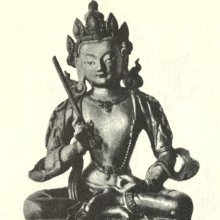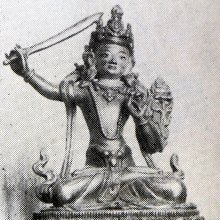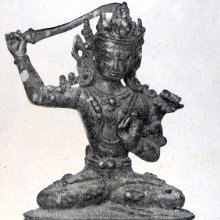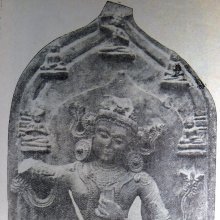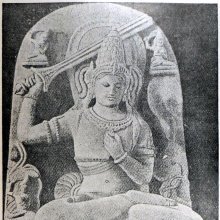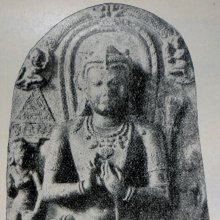Kesini, Keśinī, Keshini, Kesinī: 18 definitions
Introduction:
Kesini means something in Buddhism, Pali, Hinduism, Sanskrit, biology. If you want to know the exact meaning, history, etymology or English translation of this term then check out the descriptions on this page. Add your comment or reference to a book if you want to contribute to this summary article.
The Sanskrit term Keśinī can be transliterated into English as Kesini or Keshini, using the IAST transliteration scheme (?).
Images (photo gallery)
(+4 more images available)
In Hinduism
Purana and Itihasa (epic history)
Source: Wisdom Library: Bhagavata PuranaKeśinī (केशिनी):—One of the two wifes of Sagara (son of Bāhuka). (see Bhāgavata Purāṇa 9.8.8)
Source: Wisdom Library: The Matsya-purāṇaKeśinī (केशिनी) is the name of a mind-born ‘divine mother’ (mātṛ), created for the purpose of drinking the blood of the Andhaka demons, according to the Matsya-purāṇa 179.8. The Andhaka demons spawned out of every drop of blood spilled from the original Andhakāsura (Andhaka-demon). According to the Matsya-purāṇa 179.35, “Most terrible they (e.g., Keśinī) all drank the blood of those Andhakas and become exceedingly satiated.”
The Matsyapurāṇa is categorised as a Mahāpurāṇa, and was originally composed of 20,000 metrical verses, dating from the 1st-millennium BCE. The narrator is Matsya, one of the ten major avatars of Viṣṇu.
Source: archive.org: Puranic Encyclopedia1) Keśinī (केशिनी).—A celestial woman. In Mahābhārata, Ādi Parva Chapter 65 it is stated that the twelve celestial maids, Alambuṣā, Miśrakeśī, Vidyutparṇā, Tilottamā, Aruṇā, Rakṣitā, Rambhā, Manoramā, Keśinī, Suratā, Surajā and Supriyā were born to Kaśyapa of his wife Pradhā.
2) Keśinī (केशिनी).—The wife of Ajamīḍha, a King of the Puru dynasty. The three sons Jahnu, Vraja and Rūpiṇa were born to Ajamīḍha of his wife Keśinī. (Agni Purāṇa, Chapter 278).
3) Keśinī (केशिनी).—A maid of Damayantī. When Nala reached Kuṇḍinapurī, as Bāhuka the charioteer of Ṛtuparṇa, Keśinī approached Bāhuka at the request of Damayantī and by various tests found out that Bāhuka was Nala. (Mahābhārata Vana Parva, Chapters 74 and 75).
4) Keśinī (केशिनी).—A servant of Pārvatī. It is mentioned in Mahābhārata, Vana Parva, Chapter 231, Stanza 48 that once Pārvatī with her servant Keśinī praised Śiva.
5) Keśinī (केशिनी).—Once there arose a quarrel between Sudhanvā, the son of Aṅgiras, and Virocana the son of Prahlāda, because both wanted to marry the same girl named Keśinī. Sudhanvā was a Brahmin whereas Virocana was an Asura, who argued that Asura was nobler than Brahmin and Sudhanvā said that it was the other way. Both wagered their lives and accepted Prahlāda as their judge. The decision of Prahlāda was that the Brahmin was the nobler of the two. Because Prahlāda said the truth Sudhanvā did not kill Virocana. But Virocana had to wash the lfeet of Sudhanvā in the presence of Keśinī, feet Sudhanvā married Keśinī in the presence of Virocana. (Mahābhārata Udyoga Parva, Chapter 35).
6) Keśinī (केशिनी).—A wife of King Sagara. This Keśinī was the daughter of the King of Vidarbha. The son Asamañjasa was born to Sagara of Keśinī. (Vālmīki Rāmāyaṇa, Bālakāṇḍa, Sarga 38).
Source: Cologne Digital Sanskrit Dictionaries: The Purana Index1a) Keśinī (केशिनी).—The mother of Rāvaṇa.*
- * Bhāgavata-purāṇa VII. 1. 43.
1b) A queen of Sagara and mother of Asamañjasa; a vaṃśakarta by Aurva's grace; the daughter of Vidarbha king.*
- * Bhāgavata-purāṇa IX. 8. 15; Brahmāṇḍa-purāṇa III. 49. 2 and 59; 51. 37; 63. 154; Vāyu-purāṇa 88. 155-160; Viṣṇu-purāṇa IV. 4. 1-5.
1c) A daughter of Khaśā, and Rākṣasī. Vanquished by Kṛṣṇa.*
- * Brahmāṇḍa-purāṇa III. 7. 139; 73. 100: Vāyu-purāṇa 69. 170.
1d) The wife of Suhotra, and mother of Janhu.*
- * Brahmāṇḍa-purāṇa III. 66. 25.
1e) One of the queens of Ajamīḍha.*
- * Matsya-purāṇa 49. 44: Vāyu-purāṇa 99. 167.
1f) A mind-born mother.*
- * Matsya-purāṇa 179. 23.
Keśinī (केशिनी) is a name mentioned in the Mahābhārata (cf. I.89.28) and represents one of the many proper names used for people and places. Note: The Mahābhārata (mentioning Keśinī) is a Sanskrit epic poem consisting of 100,000 ślokas (metrical verses) and is over 2000 years old.

The Purana (पुराण, purāṇas) refers to Sanskrit literature preserving ancient India’s vast cultural history, including historical legends, religious ceremonies, various arts and sciences. The eighteen mahapuranas total over 400,000 shlokas (metrical couplets) and date to at least several centuries BCE.
Kavya (poetry)
Source: Wisdom Library: KathāsaritsāgaraKeśinī (केशिनी), daughter of Parvata, is one of the twelve female friends of Mahallikā: daughter of Prahlāda, according to the Kathāsaritsāgara, chapter 45. Accordingly, as Mahallikā said to Sūryaprabha: “... my female friends are not only two, but twelve in number, and my father’s brother carried them off from Indra’s heaven. The first is named Amṛtaprabhā, the second Keśinī; these are the auspiciously marked daughters of the hermit Parvata... They [eg., Keśinī] are all heavenly nymphs, born from Apsarases, and when I was married they were taken to the first underworld, and I must bestow them on you, in order that I may be always with them”.
The story of Keśinī and Mahallikā was narrated by the Vidyādhara king Vajraprabha to prince Naravāhanadatta in order to relate how “Sūryaprabha, being a man, obtain of old time the sovereignty over the Vidyādharas”.
The Kathāsaritsāgara (‘ocean of streams of story’), mentioning Keśinī, is a famous Sanskrit epic story revolving around prince Naravāhanadatta and his quest to become the emperor of the vidyādharas (celestial beings). The work is said to have been an adaptation of Guṇāḍhya’s Bṛhatkathā consisting of 100,000 verses, which in turn is part of a larger work containing 700,000 verses.

Kavya (काव्य, kavya) refers to Sanskrit poetry, a popular ancient Indian tradition of literature. There have been many Sanskrit poets over the ages, hailing from ancient India and beyond. This topic includes mahakavya, or ‘epic poetry’ and natya, or ‘dramatic poetry’.
Shaktism (Shakta philosophy)
Source: Kamakoti Mandali: The Yoginis of Narasimha VyuhaKeśinī (केशिनी) is the name of a Mātṛkā-Śakti created by Mahārudra in order to control the plague of demons created by Andhakāsura.—Accordingly, Andhaka-Asura tried to kidnap Umā (Devī Pārvatī), and was fiercely attacked by Mahārudra who shot arrows at him from his mahāpināka. when the arrows pierced the body of Andhakāsura, drops of blood fell to earth and from those drops, thousands of Andhakas arose. To control this plague of demons, Mahārudra created Mātṛkā-Śaktis [viz., Keśinī] and ordered them to drink the blood of the demons and drain them dry.
Source: Kamakoti Mandali: Nrisimha matrika-mandalaKeśinī (केशिनी) refers to one of the various Mātṛkā-Śaktis created by Rudra in order to destroy the clones that spawned from Andhaka’s body.—Accordingly, [...] Andhakāsura attempted to abduct Girājanandinī (Pārvatī) and thus ensued a fierce battle between Andhakāsura and the great Rudra, the Lord of Umā. Like raktabīja, every drop of blood that fell from the body of Andhaka created another Asura like him and in no time, the entire world was filled with Andhakas. To destroy the growing number of Andhakas, Rudra created innumerable Mātṛkā-Śaktis [viz., Keśinī]. These Śaktis of immense power at once began to drink every drop of blood that flowed from the body of Andhaka, but they could still not effectively contain the emergence of more and more demons.

Shakta (शाक्त, śākta) or Shaktism (śāktism) represents a tradition of Hinduism where the Goddess (Devi) is revered and worshipped. Shakta literature includes a range of scriptures, including various Agamas and Tantras, although its roots may be traced back to the Vedas.
General definition (in Hinduism)
Source: WikiPedia: HinduismKeshinī (केशिनी): Wife of Sāgara
In Buddhism
Theravada (major branch of Buddhism)
Source: Pali Kanon: Pali Proper Names1. One of the wives of Ekaraja. J.vi.134.
2. Mother of Buddhaghosa (Buddhaghosuppatti, p.38). The Sasanavamsa (p.29) calls her Kesi.
Theravāda is a major branch of Buddhism having the the Pali canon (tipitaka) as their canonical literature, which includes the vinaya-pitaka (monastic rules), the sutta-pitaka (Buddhist sermons) and the abhidhamma-pitaka (philosophy and psychology).
Tibetan Buddhism (Vajrayana or tantric Buddhism)
Source: Wisdom Library: Tibetan Buddhism1) Keśinī (केशिनी) is the name of Dūtī (i.e., messengers of Lord Vajrapāṇi) mentioned as attending the teachings in the 6th century Mañjuśrīmūlakalpa: one of the largest Kriyā Tantras devoted to Mañjuśrī (the Bodhisattva of wisdom) representing an encyclopedia of knowledge primarily concerned with ritualistic elements in Buddhism. The teachings in this text originate from Mañjuśrī and were taught to and by Buddha Śākyamuni in the presence of a large audience (including Keśinī).
2) Keśinī (केशिनी) is also the name of a Yakṣiṇī mentioned as attending the teachings in the 6th century Mañjuśrīmūlakalpa.
Source: archive.org: The Indian Buddhist IconographyKeśinī (केशिनी) is the name of a deity sometimes seen accompanying Mañjuśrī, as depicted in Buddhist Iconography.—In his simplest form Mañjuśrī carries the sword in his right hand and the Prajñāpāramitā manuscript in his left. In representations sometimes the two symbols are placed on lotuses. Sometimes Mañjuśrī is accompanied only by Yamāri, sometimes only by his Śakti or female counterpart, sometimes by Sudhanakumāra and Yamāri and sometimes again by the four divinities, Jālinīprabha (also called Sūryaprabha), Candraprabha, Keśinī and Upakeśinī. Though the last four are required to be present with Arapacana, they are nevertheless found in others also.

Tibetan Buddhism includes schools such as Nyingma, Kadampa, Kagyu and Gelug. Their primary canon of literature is divided in two broad categories: The Kangyur, which consists of Buddha’s words, and the Tengyur, which includes commentaries from various sources. Esotericism and tantra techniques (vajrayāna) are collected indepently.
Biology (plants and animals)
Source: Wisdom Library: Local Names of Plants and DrugsKeshini in the Sanskrit language is the name of a plant identified with Chrysopogon aciculatus (Retz.) Trin. from the Poaceae (Grass) family having the following synonyms: Andropogon aciculatus, Andropogon acicularis. For the possible medicinal usage of keshini, you can check this page for potential sources and references, although be aware that any some or none of the side-effects may not be mentioned here, wether they be harmful or beneficial to health.
Source: Google Books: CRC World Dictionary (Regional names)Keshini in India is the name of a plant defined with Chrysopogon aciculatus in various botanical sources. This page contains potential references in Ayurveda, modern medicine, and other folk traditions or local practices It has the synonym Andropogon acicularis Willd. (among others).
Example references for further research on medicinal uses or toxicity (see latin names for full list):
· Hooker’s Journal of Botany and Kew Garden Miscellany (1850)
· Plantarum Minus Cognitarum Pugillus (1815)
· Gramineae (1841)
· Prodromus Florae Novae Hollandiae (1810)
· Grasses of Ceylon (1956)
· Revised Handbook to the Flora of Ceylon (1931)
If you are looking for specific details regarding Keshini, for example diet and recipes, extract dosage, pregnancy safety, side effects, health benefits, chemical composition, have a look at these references.

This sections includes definitions from the five kingdoms of living things: Animals, Plants, Fungi, Protists and Monera. It will include both the official binomial nomenclature (scientific names usually in Latin) as well as regional spellings and variants.
Languages of India and abroad
Sanskrit dictionary
Source: DDSA: The practical Sanskrit-English dictionaryKeśinī (केशिनी).—
1) A woman with a beautiful braid of hair.
2) Name of the wife of Viśravas and mother of Rāvaṇa and Kumbhakarṇa; ततस्तौ राक्षसौ जातौ केशिन्यां विश्रवःसुतौ । रावणः कुम्भकर्णश्च सर्वलोकोपतापनौ (tatastau rākṣasau jātau keśinyāṃ viśravaḥsutau | rāvaṇaḥ kumbhakarṇaśca sarvalokopatāpanau) || Bhāgavata 7.1.44.
3) An epithet of Durgā.
4) Name of a plant (jaṭāmāṃsī).
Source: Cologne Digital Sanskrit Dictionaries: Edgerton Buddhist Hybrid Sanskrit DictionaryKeśinī (केशिनी).—name of a rākṣasī: Saddharmapuṇḍarīka 400.5; Mahā-Māyūrī 240.23; (presumably the same) name of a Buddhist goddess or yakṣiṇī (associated with Upakeśinī, q.v.) Sādhanamālā 113.18; 118.15; 120.2; 121.19; 131.18.
Source: Cologne Digital Sanskrit Dictionaries: Monier-Williams Sanskrit-English Dictionary1) Keśinī (केशिनी):—[from keśin > keśa] f. Name of Durgā
2) [v.s. ...] (gaṇa kurv-ādi) Name of an Apsaras, [Mahābhārata i, 2558; iii, 14562]
3) [v.s. ...] of a Rākṣasī, [Buddhist literature]
4) [v.s. ...] of the daughter of the king of Vidarbha (wife of Sagara and mother of A-samañjas), [Harivaṃśa 797 ff.; Rāmāyaṇa]
5) [v.s. ...] of the wife of Ājamīḍha (Suhotra) and mother of Jahnu, [Mahābhārata i, 3722; Harivaṃśa 1416 and 1756]
6) [v.s. ...] of the wife of Viśravas and mother of Rāvaṇa and Kumbha-karṇa, [Bhāgavata-purāṇa vii, 1, 43]
7) [v.s. ...] of a servant of Damayantī, [Nalopākhyāna xxii, 1]
8) [v.s. ...] of the daughter of a Brāhman, [Buddhist literature]
9) [v.s. ...] Chrysopogon aciculatus, [cf. Lexicographers, esp. such as amarasiṃha, halāyudha, hemacandra, etc.]
10) [v.s. ...] Nardostachys Jaṭā-māṃsī, [cf. Lexicographers, esp. such as amarasiṃha, halāyudha, hemacandra, etc.]
11) [v.s. ...] f. See kaiśina
12) [v.s. ...] f. [plural] (inīs) [Vedic or Veda] ‘the attendants of Rudra’ (See before)
13) [v.s. ...] ‘Name of certain female demons’ (See before).
Sanskrit, also spelled संस्कृतम् (saṃskṛtam), is an ancient language of India commonly seen as the grandmother of the Indo-European language family (even English!). Closely allied with Prakrit and Pali, Sanskrit is more exhaustive in both grammar and terms and has the most extensive collection of literature in the world, greatly surpassing its sister-languages Greek and Latin.
Kannada-English dictionary
Source: Alar: Kannada-English corpusKēśini (ಕೇಶಿನಿ):—[noun] the grass Chrysopogon aciculatus ( = Andropogon aciculatus) of Poaceae family.
Kannada is a Dravidian language (as opposed to the Indo-European language family) mainly spoken in the southwestern region of India.
See also (Relevant definitions)
Starts with: Kecini, Keshinishudana.
Ends with: Kecini, Manjukeshini, Sukeshini, Upakeshini.
Full-text (+30): Kaishinya, Sagara, Asamanja, Keshi, Nishacara, Keshin, Asamanjasa, Upakeshini, Five Messengers, Kecini, Sukeshini, Surasika, Adahana, Asamanjas, Kantha, Mitrasahvaya, Rupina, Apsaras, Vrajana, Yaksharakshasa.
Relevant text
Search found 31 books and stories containing Kesini, Keśinī, Keshini, Kesinī, Kēśini; (plurals include: Kesinis, Keśinīs, Keshinis, Kesinīs, Kēśinis). You can also click to the full overview containing English textual excerpts. Below are direct links for the most relevant articles:
Mahabharata (English) (by Kisari Mohan Ganguli)
Section LXXV < [Nalopakhyana Parva]
Section LXXIV < [Nalopakhyana Parva]
Section XXXV < [Udyoga Parva]
Rig Veda (translation and commentary) (by H. H. Wilson)
Ramayana of Valmiki (by Hari Prasad Shastri)
Chapter 38 - The story of King Sagara, Shri Rama’s ancestor < [Book 1 - Bala-kanda]
Chapter 52 - Lakshmana seeks out Rama < [Book 7 - Uttara-kanda]
Chapter 51 - Vishnu is cursed by Bhrigu < [Book 7 - Uttara-kanda]
Sagara < [Fourth Section]
Puranic encyclopaedia (by Vettam Mani)
